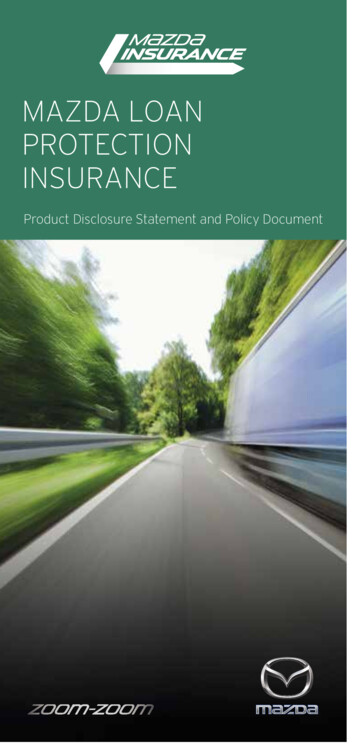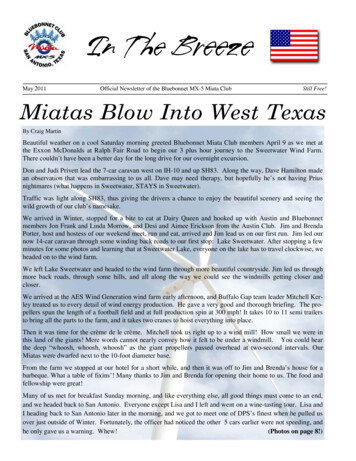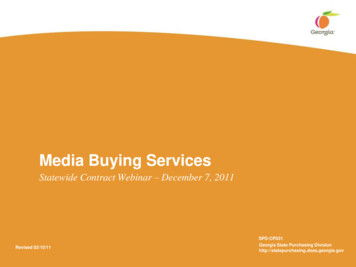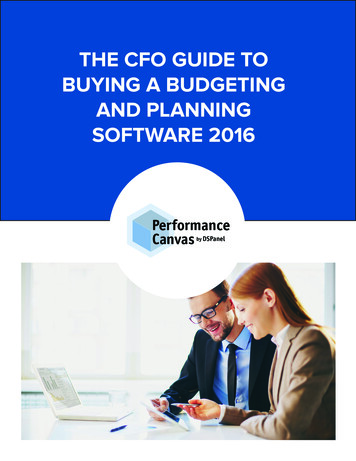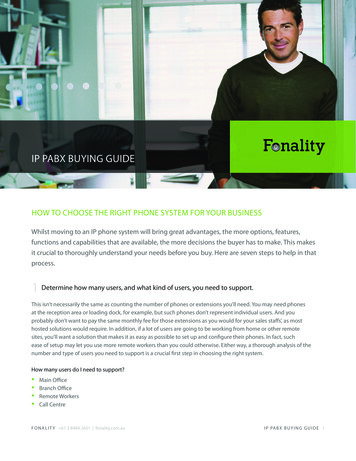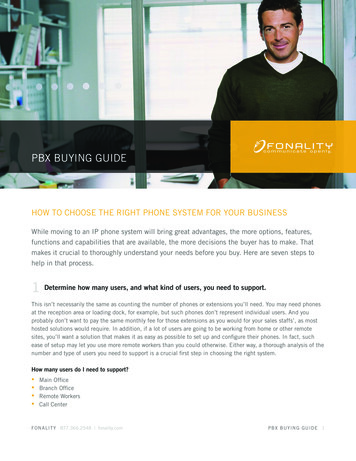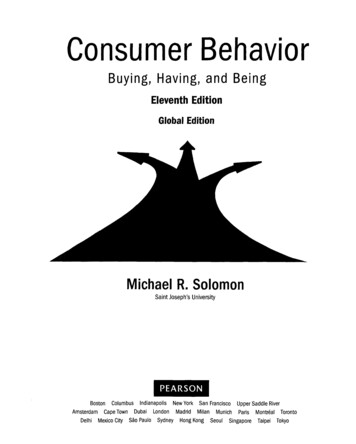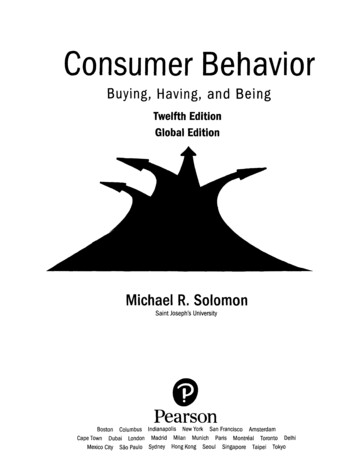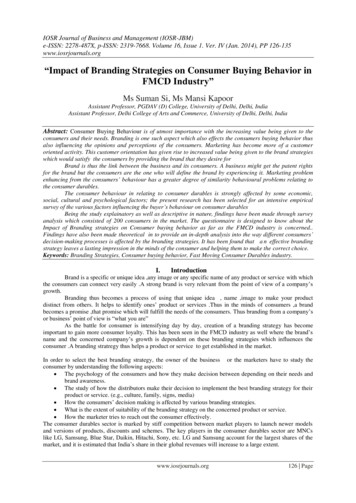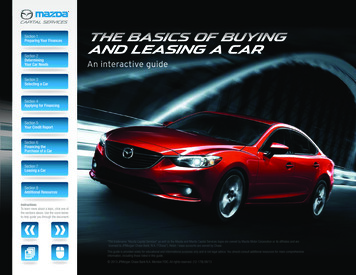
Transcription
Section 1Preparing Your FinancesSection 2DeterminingYour Car NeedsSection 3Selecting a CarSection 4Applying for FinancingSection 5Your Credit ReportSection 6Financing thePurchase of a CarSection 7Leasing a CarSection 8Additional ResourcesInstructions:To learn more about a topic, click one ofthe sections above. Use the icons belowto help guide you through the document.*The tradename “Mazda Capital Services” as well as the Mazda and Mazda Capital Services logos are owned by Mazda Motor Corporation or its affiliates and arelicensed to JPMorgan Chase Bank, N.A. (“Chase”). Retail / lease accounts are owned by Chase.This guide is provided solely for educational and informational purposes only and is not legal advice. You should consult additional resources for more comprehensiveinformation, including those listed in this guide. 2013 JPMorgan Chase Bank N.A. Member FDIC. All rights reserved. (12-179) 08/13
Section 1Preparing Your FinancesSection 2DeterminingYour Car NeedsSECTION 1PREPARING YOUR FINANCESBefore you buy or lease a car, there are a number of things you can do to help ensure that you areinformed and prepared for your upcoming financial commitment.SMART GoalsSection 3Selecting a CarSection 4Applying for FinancingSection 5Your Credit ReportSection 6Financing thePurchase of a CarSection 7Leasing a CarSection 8Additional ResourcesInstructions:To learn more about a topic, click one ofthe sections above. Use the icons belowto help guide you through the document.Shopping for a car is like shopping for any major item. Researching and budgeting upfront,followed by effective money management, will help you be financially prepared. Financing orleasing a car may have a big impact on your monthly budget, so it’s important to identify yourfinancial goals. You’re not only taking on a monthly car payment, but you’ll also have to pay otherexpenses, such as insurance, gas, registration fees and maintenance. Consider whether you canafford these expenses before committing yourself financially.Setting financial goals can help you prioritize your spending, and preparing a budget will help youkeep your spending on track. Try making your goals “SMART.” In other words, think of a generalgoal and then define it by making it Specific, Measurable, Attainable, Realistic and Time-bound.For example, you might decide you want a new car. Turn that general goal into a SMART goal bydefining it, similar to this:Defining Your SMART GoalGoal AttributesExampleSpecific:I would like to purchase a new car one year from now.Measurable:I would like to make a down payment of 2,400.Attainable:I will save 200 a month toward a down payment.Realistic:I can save 200 a month by signing up for extra hours at work.Time-bound:In one year, I will have 2,400 for a down payment bysaving 200 per month.DEFINITIONSDown PaymentAn amount paid at the time of purchasethat reduces the cash price. It caninclude any combination of cash,trade-in allowance, rebates, and othernon-cash credits.Trade-In AllowanceThe amount the dealer agrees to pay topurchase a trade-in car. If there is equityin the trade-in vehicle, the equity isapplied toward the price of the car beingpurchased or leased. If there is negativeequity, it may be added to the amountfinanced (loan) or capitalized cost(lease), increasing the total amountpaid.EquityA car’s market value above any amountowed on the loan. For example, a vehicleworth 30,000 with 20,000 remainingon the loan has 10,000 of equity.Capitalized Cost (Lease)On a lease, the “gross capitalized cost”is the amount agreed upon by the lessor(dealer) and the lessee as the valueof the vehicle and any items that arecapitalized or amortized during the leaseterm, such as taxes, insurance, serviceagreements, and any outstanding priorcredit or lease balance. The “capitalizedcost reduction” is the total amount ofany rebates, cash payment, net tradein allowance, and noncash credit thatreduces the gross capitalized cost. The“adjusted capitalized cost” is the grosscapitalized cost less the capitalizedcost reduction, and is the amount usedby the lessor in calculating the baseperiodic payment.What’s your SMART goal? Fill out this table to help define it.Goal alistic:Time-bound:RESET FORM2
Section 1Preparing Your FinancesSection 2DeterminingYour Car NeedsSection 3Selecting a CarSection 4Applying for FinancingBudgetingTIPStick to your budget. Determine thecar price range you can afford and staywithin that range.Setting a budget is key to helping you reach your financial goals. Understanding how you spendyour money will help you recognize opportunities to cut expenses and save. This can help you stayon track and move closer to your goal of purchasing or leasing a car.DeFInITIonSConsider the following questions as you begin to construct a budget:1. Who is the budget for? Is it just yourself or for your family? This will determine whether youare tracking your personal income and expenditures or those of your entire family.2. What is your timeframe? Budgets can cover a short period of time, such as a week, orlonger periods of time, such as a year or more.3. What is your income? Be sure to consider all sources.Section 5Your Credit ReportSection 6Financing thePurchase of a CarSection 7Leasing a CarComplete this table to help you determine how much money you have to apply toward yourfinancial goal(s):Total Monthly Income(Use the dollar amount from step 3 above.) 0.00What are your fixed monthly expenses? 0.00What are your variable monthly expenses? 0.00What are your discretionary expenses? 0.00Total expensesAmount AvailableincomeIncome can come from a variety ofsources, such as salary and wages,tips, incentives or bonuses, pension,child support, family or spousal support(alimony), disability, housing or militaryallowance, Social Security, etc. Whenyou apply for financing, however, youare not required to reveal child support,alimony or separate maintenanceincome if you don’t want it to beconsidered as a basis for repaying theobligation.Fixed Monthly expenseAn expense that stays the same eachmonth. examples include rent, insuranceand car payment.Variable Monthly expenseAn expense that is paid each month, butmay vary in amount. examples includeutilities, groceries and credit cardpayments. expenses may vary based onuse or consumption.Section 8Additional ResourcesInstructions:To learn more about a topic, click one ofthe sections above. Use the icons belowto help guide you through the document.BudgetA financial tool that measures expensesagainst income. A budget is designed tohelp people prioritize their spending andmanage their money for a set period oftime. 0.00Discretionary expensenon-essential expenses that may berecurring or non-recurring. examplesinclude entertainment expenses, such aseating out and vacation. 0.00 0.00 0.00RESET FORM3
Section 1Preparing Your FinancesSection 2DeterminingYour Car NeedsSection 3Selecting a CarSeCTIon 2DeTeRMininG YouR cAR neeDSConsider the following questions as you shop for a car. They will help you narrow down yourchoices and determine your needs as well as your wants. Are you interested in a new or pre-owned (used) car? Should you lease or buy? How much do you want to spend? Do you already have a car? If so, how much is it worth and will you trade it in?Section 4Applying for Financing Do you currently have an auto loan to pay off?Section 5Your Credit Report How will you use the car? Do you commute long distances, or do you simply run errandsaround town? Do you owe more on your current car than it is worth, or will you have equity to put towardsthe new car? How long will you keep the car?Section 6Financing thePurchase of a CarSection 7Leasing a CarSection 8Additional ResourcesInstructions:To learn more about a topic, click one ofthe sections above. Use the icons belowto help guide you through the document. What kinds of roads will you drive on? What features are important to you? Is it important for you to have an energy-efficient or hybrid car? Do you want an automatic or manual transmission?new car vs. Pre-owned (used)Ask yourself what kind of car you want — new or used. You want your car to fit your lifestyle andbudget. new cars are often customizable, require less maintenance and include a warranty. Used,or pre-owned, cars tend to be less expensive to purchase and insure.4
Section 1Preparing Your FinancesSection 2DeterminingYour Car NeedsSection 3Selecting a CarSection 4Applying for FinancingSection 5Your Credit ReportSection 6Financing thePurchase of a CarSection 7Leasing a CarSection 8Additional ResourcesInstructions:To learn more about a topic, click one ofthe sections above. Use the icons belowto help guide you through the document.Here are several factors to consider about a new car:Current Model Yearnew model year cars generally start arriving at dealerships between August and october of theyear prior to their model year. Models from the previous year may cost less if they remain in adealer’s inventory after the new model year cars arrive.Factory OptionsFactory options are equipment installed in cars by the manufacturer before the cars reach thedealerships. When ordering cars, all dealers select manufacturer factory options using the same“options guides.”IncentivesAsk about available incentives, which can be special low finance rates, lease specials,and/or rebates.DepreciationCars depreciate in value over time. They typically lose the most value within the first few years.However, this varies greatly among models and current market conditions. During this timeframe,the amount of your loan may be more than the value of the car. This is called negative equity.Several factors determine depreciation, including a model’s popularity, perceived quality, andsupply, among others.Manufacturer’s WarrantyDeFInITIonSDepreciationDepreciation is the estimated decreasein a car’s value over time. Projected,or expected, depreciation is used whencalculating lease terms.negative equityThe amount owed on the vehicle loan inexcess of the vehicle’s current marketvalue or agreed-upon trade-in value.For example, a vehicle worth 6,000,with 8,000 remaining on the loan has 2,000 of negative equity.Most new cars come with a manufacturer’s limited warranty. This means the manufacturerguarantees that the car and the materials used to make it are free from defects for a certainlength of time/number of miles.Typically, the cost of the manufacturer’s warranty is included in the purchase price. Warrantiesvary by manufacturer and car, as well as periods for coverage based on mileage and years. Makesure you read and understand what’s covered and what’s excluded from the warranty when youpurchase your car. To keep your warranty in effect, you may be required to operate and maintainyour car according to instructions in the owner’s manual. Keep a record of all maintenanceperformed on your car.5
Section 1Preparing Your FinancesSection 2DeterminingYour Car NeedsSection 3Selecting a CarSection 4Applying for FinancingSection 5Your Credit ReportSection 6Financing thePurchase of a CarSection 7Leasing a CarSection 8Additional ResourcesInstructions:To learn more about a topic, click one ofthe sections above. Use the icons belowto help guide you through the document.“Here are several factors to consider about a new car:” continuedNational Highway Traffic Safety Administration (NHTSA) Safety RatingFor more than 30 years, the nHTSA has provided safety ratings to consumers so they cancompare vehicles when shopping for a new car. The 5-Star Safety Ratings Program providesconsumers with crash protection and rollover safety information for new vehicles, and its newoverall Rating combines expanded crash and safety data in one single score. When shopping fora new car, this safety rating information can be found at Safercar.gov1 and on the car’s windowsticker.Here are several factors to consider about a Pre-owned (used) car:no two used cars are alike. They vary in mileage, options and condition.Manufacturer’s WarrantyUsed cars may or may not be sold with a manufacturer’s warranty. However, you may be able topurchase an extended warranty for a used car, and you may be able to add the additional cost toyour monthly car payment.Certified Pre-Owned“Certified” pre-owned cars differ from other used cars in that they must meet certainmanufacturer standards. To ensure these cars meet those standards, they are typically inspected,refurbished by a manufacturer-trained technician, and certified by the manufacturer or othercertifying authority. They also typically include a limited power train warranty, special financing,and additional benefits. Certified pre-owned programs vary significantly from one manufacturerto the next with respect to inspection standards, length and coverage of warranty, and roadsideassistance.Vehicle HistoryYou can access a vehicle history report through a number of online research tools, such ascARFAX.com.2 This report will give you details about the car’s history, including type and numberof owners and whether the car has been involved in any major accidents. If you are interestedin obtaining a report, you will need to know the car’s Vehicle Identification number (VIn). It isstamped on the vehicle in three places: on the dashboard on the driver’s side of the car near thebase of the windshield; on the front of the engine block; and on the frame’s front end. The VIn isrecorded in accidents and insurance claims and is used by mechanics to order parts.1Safercar.gov is not affiliated with or endorsed by Chase or Mazda. The Safercar.gov information and link above is forinformational purposes only, and neither Chase nor Mazda are responsible for any information, products or servicesprovided by or through national Highway Traffic Safety Administration or Safercar.gov.2CARFAX.com is not affiliated with or endorsed by Chase or Mazda. The CARFAX.com information and link above is forinformational purposes only, and neither Chase nor Mazda are responsible for any information, products or servicesprovided by or through CARFAX, Inc. or CARFAX.com.6
Section 1Preparing Your FinancesSection 2DeterminingYour Car NeedsSection 3Selecting a CarSection 4Applying for FinancingSection 5Your Credit ReportSection 6Financing thePurchase of a CarSection 7Leasing a CarSection 8Additional ResourcesInstructions:To learn more about a topic, click one ofthe sections above. Use the icons belowto help guide you through the document.SeCTIon 3SeLecTinG A cARLet’s assume you’ve already done your homework. You’ve researched manufacturer websitesand visited others like edmunds.com3 and cars.com,4 where you can find helpful links, pricingestimates and even car reviews and photos. Perhaps you have already checked the Internet oryour local newspaper to locate particular cars you’re interested in. Most importantly, you’veconsidered your budget. If you are financing, online calculators can help you determine whatyour monthly payments will be. Many websites allow you to experiment with online calculators,entering different interest rates into these calculators to view different financing and paymentscenarios.There are different options available, whether you plan to lease or finance. Your credit rating,along with other factors, will determine how much you can finance or lease, as well as yourmonthly payment. If you decide to finance your purchase, your credit rating will also determineyour annual percentage rate (APR).Visiting a DealershipHow do you find a dealership that you’ll feel comfortable doing business with now and in thefuture? Again, research websites, consult the Better Business Bureau,5 and ask your friendsand neighbors. Some factors that might be important to you may include inventory, mechanicservices/body shop, shuttle services or service loaner cars if you require repairs, manufacturerrebates, or handicap accessibility, for example.When you visit a dealership, make sure that the window sticker — which includes theManufacturer’s Suggested Retail Price (MSRP) destination fees and any nHTSA 5-Star SafetyRating — is displayed on any new car you’re interested in buying or leasing. This sticker shows theMSRP base price of the car and lists standard equipment, installed options, freight charges, fueleconomy, and warranty information. Federal law (and state laws in Maine and Wisconsin) requiredealers to post a Buyer’s Guide for used cars on every used car offered for sale at a dealership.Make sure you receive a copy, as it becomes part of your purchase contract. If the guide lists thatthe car is sold with a warranty, the dealer is required to give you a copy of the written warranty.The guide also will note whether the car is being sold “as is.” If the dealer makes any additionalpromises beyond what is noted on the Buyer’s Guide, get the details in writing.DeFInITIonSAnnual Percentage Rate (APR)on a loan or other credit transaction,the APR is the cost of credit expressedas a yearly rate. The APR is based onall finance charges known at the timethe financing contract is entered into,assuming all payments are made ontime over the contract term.contract or Lease TermThe period of time, in months, from thebeginning of the financing contract orlease to the scheduled maturity date,as disclosed in the financing contractor lease.Manufacturer’s SuggestedRetail Price (MSRP)The base price of a car, including allfactory-installed options. It may or maynot include destination charges. TheMSRP is shown on the car’s windowsticker when the car arrives from thefactory. Also known as the sticker price.Learn more from the Federal Trade commission about buying a used car.3edmunds.com is not affiliated with or endorsed by Chase or Mazda. The edmunds.com information and link aboveis for informational purposes only, and neither Chase nor Mazda are responsible for any information, products orservices provided by or through edmunds Automotive network. or edmunds.com.4Cars.com is not affiliated with or endorsed by Chase or Mazda. The Cars.com information and link above is forinformational purposes only, and neither Chase nor Mazda are responsible for any information, products or servicesprovided by or through Classified Ventures, LLC or Cars.com.5BBB.org is not affiliated with or endorsed by Chase or Mazda. The BBB.org information and link above is forinformational purposes only, and neither Chase nor Mazda are responsible for any information, products or servicesprovided by or through the Better Business Bureau or BBB.org.7
Section 1Preparing Your FinancesSection 2DeterminingYour Car NeedsSection 3Selecting a CarSection 4Applying for FinancingSection 5Your Credit ReportSection 6Financing thePurchase of a CarTest DrivingWhen you test drive a car, think back to the questions you asked yourself earlier in sections oneand two. Does the car you’re test driving meet the needs you identified? Try to drive the car inconditions similar to those you usually experience. You might need to drive other cars on the lotor visit a different dealership. Compare cars. Continue your research. Consider how each car youtest drive will meet your needs and fit your lifestyle.When you’ve decided on a car, sit down and talk with a salesperson. The salesperson probablywill ask you questions like these: What is your name and address? How will you pay for the car?º Will you apply for financing through a dealership or retailer (available for a retailinstallment sale or a lease)?º Will you obtain a loan directly through your bank or some other institution?º Will you pay with cash? What would you like your monthly payment to be?Section 7Leasing a Carnegotiating the car’s price is an important step in the overall car buying process. Remember, thekey factors that determine your monthly payment are: selling price, down payment/trade equity,term and interest rate. If you have done your homework in advance, you should know the carprice that will get you the
Instructions: To learn more about a topic, click one of . the sections above. Use the icons below to help guide you through the document. *The tradename “Mazda Capital Services” as well as the Mazda and Mazda Capital Services logos are
